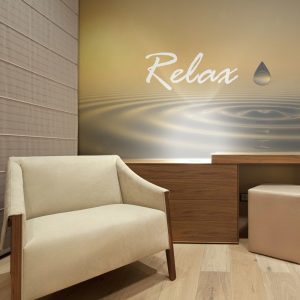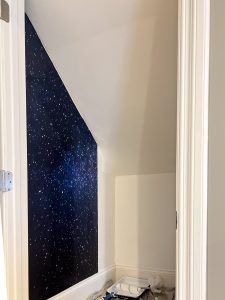Proper wall preparation is crucial for successful mural installation. Neglecting this step can lead to adhesion problems and premature peeling.
A. Cleaning the Wall Thoroughly
Before applying the mural, thoroughly clean the wall surface to remove any dust, dirt, grease, or residue from previous wallpaper or paint. Use a mild detergent solution or wall cleaner to ensure a clean and smooth surface for optimal adhesion.
B. Smoothing Out Imperfections and Removing Loose Paint
Any bumps, cracks, or uneven textures on the wall can affect the mural’s ability to adhere properly. Address these imperfections by filling in cracks or holes with spackling compound and using sandpaper to smooth out rough areas. Additionally, remove any loose or flaking paint to create a stable and even surface.
C. Applying Primer if Necessary for Better Adhesion
In some cases, applying a primer to the wall can enhance the mural’s adhesion. This is particularly important for surfaces with high porosity or those that have been recently painted with low-VOC or stain-blocking paints, which can interfere with the adhesive’s effectiveness.
II. Avoiding Alignment and Pattern Matching Mistakes
Improper alignment and pattern matching can result in a visually unappealing outcome and disrupt the overall aesthetic of the mural.
A. Measuring and Marking Reference Points for Straight Panels
Begin by measuring and marking reference po check my source ints on the wall, ensuring a straight starting line for the first panel. This will help you maintain proper alignment throughout the installation process.
B. Using a Level or Plumb Line for Vertical Alignment
Use a level or plumb line to ensure vertical alignment of each panel. Even a slight deviation can lead to noticeable misalignment as you progress with the installation.

C. Examining Pattern Repeat Before Installation
For patterned murals, unroll and examine each panel before installation to understand the pattern repeat and how it aligns with adjacent panels. This will help you avoid mismatched patterns and ensure a seamless transition between panels.
D. Smoothing Out Bubbles and Wrinkles While Applying Each Panel
As you apply each panel, start from the top and work your way down, smoothing out any air bubbles or wrinkles as you go. Use a wallpaper smoothing tool or squeegee to press the mural firmly onto the wall and ensure proper adhesion.
III. Preventing Air Bubbles and Wrinkles
Air bubbles and wrinkles can compromise the smooth and flawless appearance of the mural. Here are effective techniques for removing them:
A. Applying Mural from the Center Outward
Begin by applying the mural in the center of the panel and gradually work your way towards the edges. This helps to evenly distribute the mural and minimize the chances of trapping air bubbles.
B. Using a Wallpaper Smoothing Tool to Press Out Air Pockets
A wallpaper smoothing tool or squeegee is invaluable for eliminating air bubbles and wrinkles. After applying the mural, use the tool to firmly press the mural onto the wall, working from the center outwards. Apply even pressure and move the tool in smooth, sweeping motions to ensure proper adhesion and eliminate any air pockets.
C. Lifting and Re-smoothing Sections if Bubbles Appear
If you notice the presence of air bubbles, gently lift the affected area of the mural and use the smoothing tool to press out the trapped air. Start from the center of the bubble and push towards the edges, smoothing the mural as you go.
IV. Ensuring Proper Adhesion to Prevent Peeling
Insufficient adhesion can lead to peeling, compromising the mural’s appearance and longevity. Here are some tips to ensure proper adhesion:
| Technique | Description |
|---|---|
| Thoroughly Cleaning the Wall Surface | Remove any dust, dirt, or residue that can interfere with adhesion. |
| Applying Sufficient Pressure | Use a wallpaper smoothing tool or squeegee to apply firm pressure and ensure proper adhesion. |
| Using a Primer | Apply a primer to enhance adhesion, especially on porous or recently painted surfaces. |
| Avoiding Moisture Exposure | Excessive moisture can weaken the adhesive and cause peeling. |
If you notice any sections of the mural that have started to peel, address them promptly to prevent further damage. Gently lift the peeled section, apply a small amount of adhesive to the back, and press it firmly onto the wall, following the manufacturer’s instructions.
V. Fixing Overlapping or Gapping Issues
Overlapping or leaving gaps between mural panels can detract from the intended aesthetic and compromise the seamless finish of the installation.
A. Carefully Aligning Panels to Avoid Overlaps and Gaps
Pay close attention to the alignment of each panel to avoid overlaps and gaps. Use a level or plumb line to ensure proper alignment, and double-check the pattern repeat before proceeding.
B. Lifting and Repositioning Panels While the Adhesive is Still Tacky
If you notice an overlap or gap, act quickly while the adhesive is still tacky. Gently lift the affected panel and reposition it to achieve the desired alignment.
C. Using a Sharp Utility Knife to Trim Excess Material at Seams
In some cases, trimming excess material at seams may be necessary to achieve a seamless finish. Use a sharp utility knife to carefully trim any overlapping sections, ensuring a clean and precise cut.
VI. Dealing with Wallpaper Stains and Tears
Accidents can happen during the installation process, leading to stains or tears in the mural. Here’s how to address these issues:
A. Preventing Paste Stains by Removing Excess Adhesive Immediately
To prevent paste stains, remove any excess adhesive immediately after applying the mural. Use a clean, damp cloth to gently wipe away any residue before it has a chance to dry and stain the surface.
B. Wearing Gloves to Avoid Transferring Adhesive to the Mural Surface
Wear gloves during the installation process to avoid transferring adhesive or other substances to the mural surface, which can lead to stains or discoloration.
C. Carefully Cutting Wallpaper with a Sharp Blade to Prevent Tearing
When cutting the mural, use a sharp blade or utility knife to ensure clean and precise cuts. Dull blades can tear or fray the material, compromising the overall appearance.
D. Replacing Torn or Stained Panels if Necessary for Best Results
In cases of severe staining or tearing, it may be necessary to replace the affected panels to maintain the mural’s visual appeal. Follow the manufacturer’s instructions for proper replacement and ensure a seamless transition between panels.
VII. Accounting for Textured Walls and Corners
Textured walls and corners can present unique challenges during mural installation. Here’s how to address them:
A. Using Liner Paper or Sanding Textured Surfaces Before Application
For textured walls, consider using liner paper or sanding the surface to create a smoother base for the mural. This will help ensure proper adhesion and prevent air pockets or bubbles from forming.
B. Measuring and Pre-cutting Panels for Inside Corners
Inside corners can be tricky to navigate. Measure and pre-cut panels to fit these areas, ensuring a clean and precise installation.
C. Overlapping Mural Strips Slightly in Corners and Trimming Excess
When installing the mural in corners, overlap the strips slightly and use a sharp utility knife to trim any excess material. This will help achieve a seamless finish and prevent gaps or overlaps.
VIII. Protecting Murals from Light Damage and Humidity Changes
Environmental factors such as light exposure and humidity changes can impact the longevity and appearance of your mural.
A. Using UV-blocking Window Coverings in Rooms with Direct Sunlight
In rooms with direct sunlight, consider using UV-blocking window coverings to protect the mural from fading or discoloration caused by prolonged light exposure.
B. Maintaining a Stable Indoor Climate to Prevent Peeling and Bubbling
Drastic temperature and humidity changes can cause the mural to expand or contract, leading to peeling or bubbling. Maintain a stable indoor climate by using air conditioning or dehumidifiers as needed.
C. Sealing Murals on Exterior Walls to Block Out Moisture
For exterior walls, consider sealing the mural with a clear, water-resistant sealant to protect it from moisture and environmental factors that can cause premature deterioration.
IX. Conclusion
Peel and stick murals offer a versatile and cost-effective way to transform any space, but proper installation is key to achieving a flawless and long-lasting result. By following the tips and techniques outlined in this guide, you can overcome common challenges and ensure a successful mural application.

Hi there! My name is Ashton Pulsford and I’m an interior designer. I love making spaces look beautiful and feel cozy.
I started EasyWalls to share tips and ideas for decorating your home with wallpaper. Wallpaper is a fun way to add color and patterns to your walls. But it can be tricky to put up and take down. That’s where I come in!




